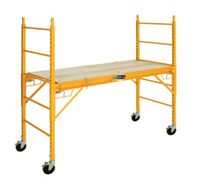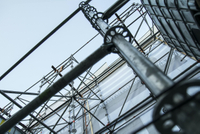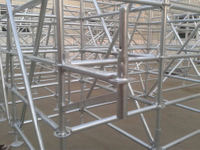Content Menu
● Importance of Ringlock Scaffolding Inspection
● Standards and Regulations Guiding Ringlock Scaffolding Inspection
● Inspection Schedule and Frequency
● Key Components to Inspect on Ringlock Scaffolding
● Step-by-Step Ringlock Scaffolding Inspection Procedure
>> 1. Preparation and Safety Measures
>> 2. Visual and Physical Checks on Components
>> 3. Testing and Stability Verification
>> 4. Addressing Deficiencies
>> 5. Final Documentation and Tags
● Common Issues Found During Inspection and How to Address Them
● Documentation and Record-Keeping for Compliance
● Conclusion
● FAQ
>> 1. How often should ringlock scaffolding be inspected?
>> 2. Who is qualified to inspect ringlock scaffolding?
>> 3. What are the most common safety issues found during inspections?
>> 4. How important is documentation in scaffolding inspection?
>> 5. Can improper inspection void scaffolding safety standards?
Ringlock scaffolding has become one of the most popular modular scaffolding systems worldwide due to its versatility, rapid assembly, and strong safety performance. However, regular inspection of ringlock scaffolding is essential to ensure it remains safe and compliant with prevailing standards throughout its use on any construction site.

Importance of Ringlock Scaffolding Inspection
Ringlock scaffolding enables rapid erection and dismantling of temporary work platforms but, like any scaffolding system, it must be inspected regularly to maintain structural integrity and worker safety. Unsafe scaffolding structures risk collapse, falling debris, and serious injuries or fatalities.
Regular inspections prevent accidents, verify compliance with safety regulations, and prolong equipment life. Inspection is a legal and contractual requirement across most construction jurisdictions, including standards such as EN 12810, EN 12811, and workplace health and safety regulations globally.
Standards and Regulations Guiding Ringlock Scaffolding Inspection
Ringlock scaffolding inspection must comply with relevant codes, including:
- EN 12810-3D-SW06/307-H2-A-LS: European façade scaffold standard
- EN 12811: Performance requirements for scaffolding structures
- DIBt Approval Z-8.22-992: German building authority certification
- OSHA (United States): Safety guidelines including required inspection intervals and competent persons
Inspection personnel must be qualified and trained (often termed “competent person” per OSHA) and understand the specific risks and components unique to ringlock systems.
Inspection Schedule and Frequency
Doka, a major ringlock scaffolding supplier, recommends inspections:
- Before the first use of scaffold after erection
- After any modification or alteration to the scaffold
- After adverse weather events such as storms or strong winds
- At regular intervals, typically at least every 30 days or as per site procedures
Additionally, daily visual checks by workers using the scaffold help identify immediate hazards such as loose components or debris.

Key Components to Inspect on Ringlock Scaffolding
Thorough inspection covers every element:
Component |
Inspection Focus |
Vertical Standards |
Check for bends, cracks, corrosion, and damage to rosettes |
Horizontal Ledgers |
Verify secure wedge connections, straightness, and wear |
Rosette Joints |
Confirm wedges are fully engaged and locked |
Base Plates/Jacks |
Ensure level positioning, no ground settlement |
Diagonal Braces |
Check tension, alignment, absence of deformation |
Steel Platform Planks |
Inspect for cracks, properly seated on ledgers, anti-slip condition |
Guardrails and Toe Boards |
Confirm installation and condition |
Access Points (Ladders, Stairs) |
Secure attachment, no slippage or damage |
Load Signage and Tags |
Verify legibility and up-to-date inspection tags |
Step-by-Step Ringlock Scaffolding Inspection Procedure
1. Preparation and Safety Measures
- Ensure inspecting personnel have appropriate PPE (helmets, harnesses, gloves, etc.)
- Review latest assembly drawings and manufacturer specs
- Establish safe access for inspection at height
2. Visual and Physical Checks on Components
- Standards and Rosettes:
- Look for signs of corrosion, cracks, or distortion
- Test wedge locks on rosettes for tight fit without excessive play
- Ledgers and Braces:
- Confirm full insertion into rosette slots and no missing wedges
- Examine for metal fatigue or bends, replace if defective
- Base Plates / Jacks:
- Verify scaffold base is supported on stable, level ground or sole boards
- Platforms:
- Confirm planks are fully laid with no protrusions
- Check anti-slip surfaces and absence of contamination (oil, debris)
- Guardrails / Toe Boards:
- Ensure continuous guarding at edges and openings per safety regulations
- Access Routes:
- Check ladders or stairs are firmly attached
- Ensure clear, unobstructed egress
3. Testing and Stability Verification
- Use load tests where necessary to simulate working loads as per EN standards
- Check lateral stability through tensioning of diagonal braces
- Inspect scaffold ties to structural elements for secure attachment
4. Addressing Deficiencies
- Immediately remove damaged or suspect components from service
- Replace or repair components per manufacturer guidelines
- Re-secure loose wedges or clamps
5. Final Documentation and Tags
- Record inspection date, findings, remedial actions, and inspector name
- Attach updated scaffold inspection tags at scaffold entry points
- Communicate any usage limitations or restrictions to site personnel
Common Issues Found During Inspection and How to Address Them
Issue |
Cause/Reason |
Recommended Action |
Loose or missing wedge pins |
Vibration, improper installation |
Replace pins and verify locking before use |
Corroded or cracked components |
Exposure to weather, poor maintenance |
Remove and replace damaged parts |
Unstable base or uneven ground |
Poor ground preparation |
Re-level using sole boards or base jacks |
Damaged guardrails or toe boards |
Impact or wear |
Repair or replace immediately |
Overloading signs missing |
Oversight or wear |
Update signage and inform site users |
Failure to promptly address these can lead to scaffold failure and serious accidents.
Documentation and Record-Keeping for Compliance
Accurate records make inspections transparent and traceable:
- Maintain a detailed inspection checklist for every scaffold
- Use scaffold tag systems indicating last inspection date and approved working load
- Store inspection forms digitally or physically per company and regulatory policies
- Regularly review records to identify recurring issues or training needs
Conclusion
Proper and regular inspection of ringlock scaffolding is critical for maintaining a safe working environment on construction sites. Following the recommended procedures, adhering to standards like EN 12810/12811 and OSHA requirements, and ensuring inspections are performed by competent personnel will significantly reduce scaffold-related risks. Inspections must be systematic, cover all key components, identify and correct defects promptly, and be well documented.
By embracing a culture of diligent inspection and maintenance, companies can maximize the efficiency, safety, and lifespan of ringlock scaffolding, protecting workers and project timelines.

FAQ
1. How often should ringlock scaffolding be inspected?
Ringlock scaffolding should be inspected before first use, after any modifications, after adverse weather, and routinely every 30 days or as per site-specific safety protocols.
2. Who is qualified to inspect ringlock scaffolding?
Only trained, competent personnel familiar with ringlock modular systems and local safety regulations should conduct inspections.
3. What are the most common safety issues found during inspections?
Loose wedge pins, corrosion, damaged components, unstable bases, and missing guardrails are frequent problems identified.
4. How important is documentation in scaffolding inspection?
Documentation provides proof of compliance, helps track scaffold condition over time, and is often required for regulatory audits or insurance.
5. Can improper inspection void scaffolding safety standards?
Yes, failure to inspect and maintain ringlock scaffolding properly can result in unsafe conditions, legal penalties, and increased accident risk.






















